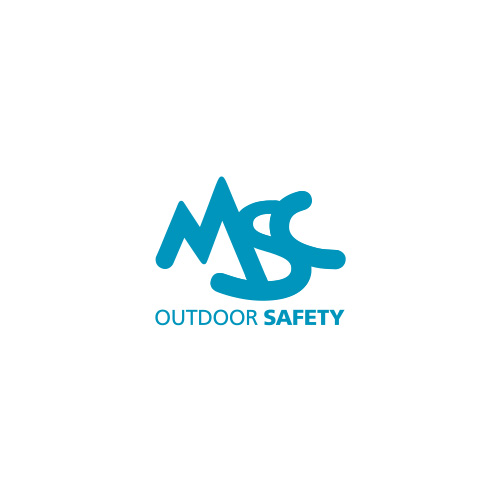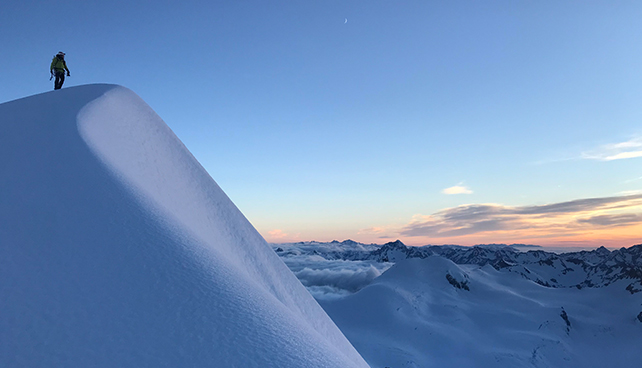
New Zealand conditions are unlike anywhere else on Earth. This part of the world is home to many variables – from the subtropical beaches of the winterless North, to the harsh yet awe-inspiring glaciers and snow-capped mountains of the rugged South. The weather is highly changeable – any local will tell you that ‘four seasons in one day’ is no exaggeration, and that is no truer than in winter.
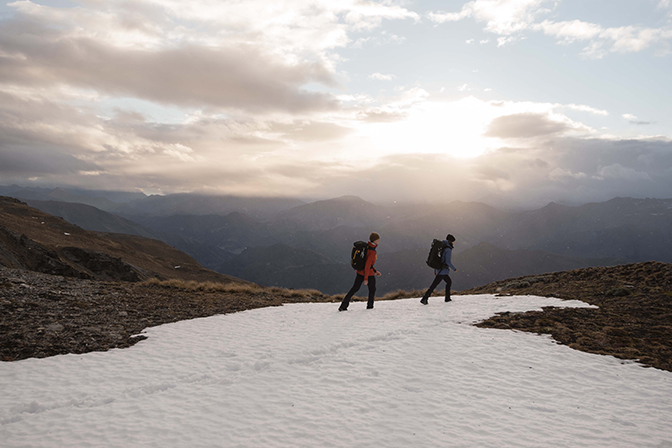
Winter tramping in NZ is a magical experience
Walking (or ‘tramping’ as affectionately known by us Kiwis) is the most popular of all the land-based recreation activities, and for good reason. We are blessed with some of the world’s greatest tracks that host locals and visitors alike in the New Zealand wilderness. While our tracks are hugely popular in the warmer months, there are many reasons tramping in winter makes for an unforgettable experience. The crisp, cool air is incredibly refreshing, the tracks are significantly quieter – you may head out for several days and not see another human being. In winter, many of these areas are also subject to regular snowfall making for an even more beautiful experience as the sunlight dances across the white blanketed landscape. Beautiful though it may be, winter tramping comes with tougher conditions that you need to be prepared for.
Whether you’re tramping for a few days, or going bush for just a matter of hours, it’s important to be aware of whatever the environment and climate may throw your way. We want to make sure your winter adventures are both enjoyable and safe, so this week, we’ve partnered with the knowledgeable team at the New Zealand Mountain Safety Council to pass on some top tips you need to be aware of before you head out on your trip.
Check the forecast – take an all-conditions approach
What we mean by this is don’t just watch the weather segment at the end of the news the night before you go. There are lots of sources for weather information in New Zealand, and the best place to start is MetService. Don’t just check the general forecast for urban centres – look at the rural forecast and mountain forecast. Remember, the forecast is just a prediction – conditions can always change, often very quickly. Make sure you check the forecast regularly for several days right up until the day you leave, and even if it’s showing sunny skies, be prepared for rain, snow or sleet.
If the weather isn’t looking great, you need to consider whether changing your plans might be a safer option. Remember, tougher conditions mean your trip may take longer (an afternoon walk can quickly become a night in the bush, so you may need more supplies). You may need to rethink where you’ll sleep, rivers will rise and the track will become slippery with mud if it rains or snow melts, and the harsh Kiwi sun will burn no matter what time of year it is.
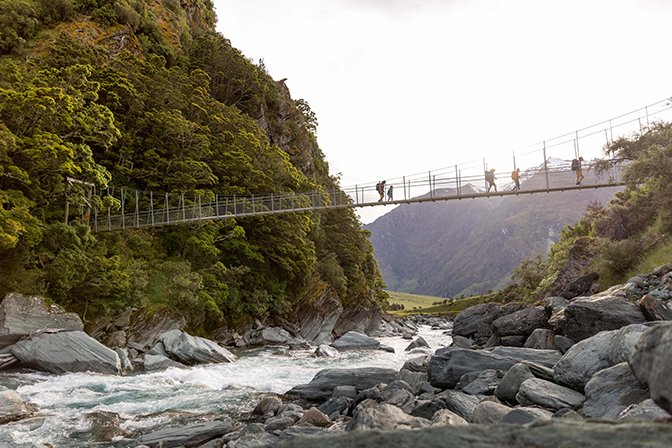
If you need to cross a river, always look for a bridge to safely get across if you can.
Plan around rivers – ‘If in doubt, stay out.’
There are about 180,000km of rivers in New Zealand, so chances are you’ll come across a river crossing on your trip. Make sure you thoroughly research the area before you head off. Check maps for bridges – while many popular tracks will have swing bridges and cable ways, tramping in winter in the backcountry often includes crossing rivers. If you’re inexperienced with rivers, then you should plan your trip around bridges, and always be prepared to change your plans.
Crossing a river is serious business – serious injuries and even fatalities occur during river crossings in New Zealand every year. Do not underestimate any river crossing – it’s easy to lose your footing or slip, especially with a heavy pack on your back.
Rivers can be very unpredictable – even the tamest stream can quickly become flooded and dangerous in rain or when snow melts – not to mention freezing cold. If you come across a river you’re unsure of on your trip, don’t panic, and do not attempt to cross it if you are not experienced in identifying and crossing unsafe rivers. Always be prepared to turn around, change to a different track or wait for the water level to drop.
If you need to cross a river, then you first need to assess any hazards:
- Check how fast the river is flowing. If it’s faster than walking pace, then assume it’s unsafe.
- Check how deep it is – you shouldn’t attempt to cross a river that reaches higher than thigh height on the smallest member of your group.
- Can you see the bottom of the river? Is the water clear? If it’s murky, do not attempt to cross.
- Assess whether the river is in flood – can you hear stones rolling on the river bed, or see discolouration, surges and debris from trees in the water? If so, it’s unsafe to cross.
If the river is safe to cross, find a safe, calm section to navigate that isn’t too deep. Avoid steep banks, white water, rapids and river edges with anything that could get in your way such as fences and tree roots. Remember, if in doubt, stay out!
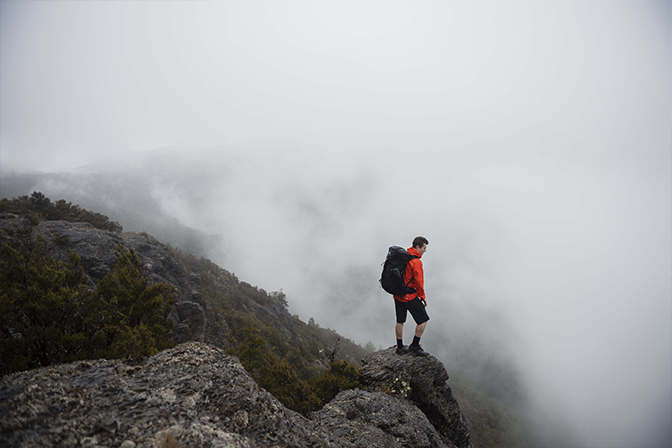
Waterproof yourself and your gear
Regardless of how good the weather appears to be and the length of time you’re heading out for, you should always have a rain jacket on you to keep you protected from the elements. It may seem simple, but when the conditions turn bad, your rain jacket will make all the difference – it could even save your life. Wet can quickly mean cold, and cold is dangerous. Choose a rain jacket that has a waterproof rating of at least 5,000 hydrostatic head – the higher the rating, the better especially if it’s really pouring down. Rain jackets can be exceptionally lightweight and compact, so if weight and space is an issue, there’s still no reason to compromise on whether or not to take proper rainwear.
You can also keep your gear safe and dry by using a pack rain cover as well as a pack liner inside of your pack. There’s nothing that turns a good day into a drag faster than soggy sandwiches, waterlogged maps and damp insulation. But it’s when important (and expensive) items like head torches, GPS devices and phones become wet and damaged that serious issues can occur and cause dramatic changes to the trip.
Brave the cold sensibly
When you’re tramping in New Zealand in winter conditions, there is a greater risk of and hypothermia. This is when your core body temperature drops to a level where your body cannot cope and starts shutting down functions to survive and make up for the heat lost. This usually happens when your temperature dips below 35°C.
You can avoid this dangerous condition by ensuring you’re properly equipped:
- Choose the right clothing: avoid cotton layers as these can’t keep you warm if they become wet. Wool and polyester synthetics have better moisture management, drawing perspiration away from your body so you can stay warm. Make sure you always have a quality outer layer to keep the wind and rain out – prolonged exposure to the weather can leave you freezing cold and wet and could leave you hypothermic
- Always take a survival kit: each person in your group should carry their own survival kit in a waterproof container. Check out the New Zealand Mountain Safety Council’s supply recommendations for more information.
- Sustain yourself with good food, and keep hydrated: in cooler conditions, your body needs more energy to stay warm. Choose nutritious food, and make sure you have enough water.
Learn to navigate
Dark valleys have less daylight hours as it is– but in winter, it’s going to get darker and colder everywhere much faster. This, combined with adverse weather conditions and slippery terrain can make it harder for you to properly track your location in the cooler months.
While you can always take a GPS tracker, it’s also important that you know how to properly read a map – in some conditions, this may be your most reliable method of navigation. A topographical map should be part of your essential kit whenever you’re adventuring in the outdoors. These highly detailed maps will help you to figure out your location based on landmarks and roads in the area. Check out this video to learn how to read a topographical map.
A map and compass go hand-in-hand – many people don’t know how to use a compass, but it’s not difficult to learn, and it really is an essential skill on any tramping trip in New Zealand.
Should you become lost, don’t panic and wander aimlessly. Stay calm, observe your surroundings and look for any significant landmarks. Take out your map, and figure out where you started. Track your journey as best you can.
We all love getting outdoors – but in order for your trip to be enjoyable, it’s so important you plan for a safe experience. For more information, please check out the New Zealand Mountain Safety Council website.
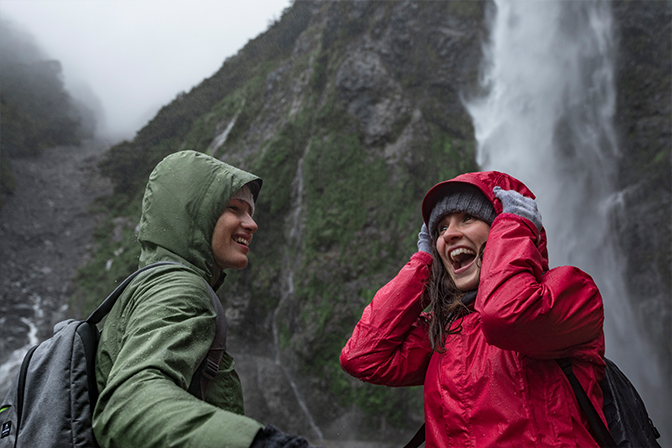
Winter tramping in NZ should not only be fun – but safe!
Top image by Jack Austin.
